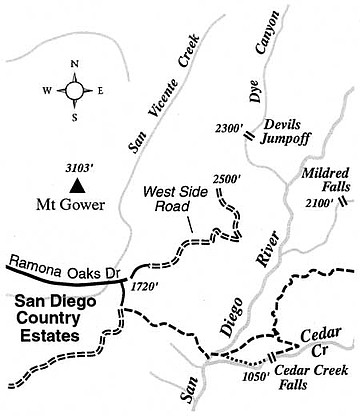 Facebook
Facebook
 X
X
 Instagram
Instagram
 TikTok
TikTok
 Youtube
Youtube
With a little hyperbole added, you might think of the upper San Diego River area as being San Diego County's "Little Yosemite." A number of waterfalls 100 or so feet high exist either on the main San Diego River, or along its tributaries. None are much to look at most of the year, but all revive in a dramatic way after periods of heavy rainfall. Cedar Creek Falls and Mildred Falls come to mind immediately -- but a lesser-known cascade called Devils Jumpoff is also worth a look this season, assuming we get a good dose of precipitation.
The rim of the Devils Jumpoff cliff lies on private land with no access. The bottom of the cliff can be reached over national forest territory, but a difficult canyon-bottom hike would be required to reach it. Despite those impediments, a distant view of the Jumpoff is possible if you're willing to drive out to San Diego County Estates and walk for just two miles along Cleveland National Forest's West Side Road.
Use either Wildcat Canyon Road out of the Lakeside or San Vicente Road south of Ramona to drive into the rural housing development of San Diego Country Estates. Continue east on San Vicente Road and Ramona Oaks Road to reach the farthest eastern point within the development, right on the boundary of Cleveland National Forest.
Park on the street and walk up the "driveway" that curls north and uphill alongside the easternmost houses. After 0.1 mile you pass a gate that keeps vehicles out. After another 0.3 mile, pavement ends. Continue walking uphill on the unpaved West Side Road. The mountainsides here and for as far as the eye can see were scorched during the early phases of the Cedar Fire. Now, more than three years later, the chaparral vegetation is growing back, and a fraction of the scattered oak trees -- Engelmann oaks and coast live oaks -- are showing signs of survival.
After 2.0 miles of gradual ascent, totaling 800 feet of elevation gain, you reach a makeshift barrier. This is where the national forest land ends and unposted private property lies ahead. By this time, you may have already heard the distant roar of cascading water.
From the road's end, hike east or northeast about 200 yards, dodging low-growing shrubbery, to a crest where Dye Canyon yawns ahead, and the Jumpoff lies in clear sight about half a mile away. There, a bubbly mixture of water bounces down more than 100 feet of the nearly sheer face of the cliff. Binoculars will surely enhance the view.
This article contains information about a publicly owned recreation or wilderness area. Trails and pathways are not necessarily marked. Conditions can change rapidly. Hikers should be properly equipped and have safety and navigational skills. The Reader and Jerry Schad assume no responsibility for any adverse experience.


With a little hyperbole added, you might think of the upper San Diego River area as being San Diego County's "Little Yosemite." A number of waterfalls 100 or so feet high exist either on the main San Diego River, or along its tributaries. None are much to look at most of the year, but all revive in a dramatic way after periods of heavy rainfall. Cedar Creek Falls and Mildred Falls come to mind immediately -- but a lesser-known cascade called Devils Jumpoff is also worth a look this season, assuming we get a good dose of precipitation.
The rim of the Devils Jumpoff cliff lies on private land with no access. The bottom of the cliff can be reached over national forest territory, but a difficult canyon-bottom hike would be required to reach it. Despite those impediments, a distant view of the Jumpoff is possible if you're willing to drive out to San Diego County Estates and walk for just two miles along Cleveland National Forest's West Side Road.
Use either Wildcat Canyon Road out of the Lakeside or San Vicente Road south of Ramona to drive into the rural housing development of San Diego Country Estates. Continue east on San Vicente Road and Ramona Oaks Road to reach the farthest eastern point within the development, right on the boundary of Cleveland National Forest.
Park on the street and walk up the "driveway" that curls north and uphill alongside the easternmost houses. After 0.1 mile you pass a gate that keeps vehicles out. After another 0.3 mile, pavement ends. Continue walking uphill on the unpaved West Side Road. The mountainsides here and for as far as the eye can see were scorched during the early phases of the Cedar Fire. Now, more than three years later, the chaparral vegetation is growing back, and a fraction of the scattered oak trees -- Engelmann oaks and coast live oaks -- are showing signs of survival.
After 2.0 miles of gradual ascent, totaling 800 feet of elevation gain, you reach a makeshift barrier. This is where the national forest land ends and unposted private property lies ahead. By this time, you may have already heard the distant roar of cascading water.
From the road's end, hike east or northeast about 200 yards, dodging low-growing shrubbery, to a crest where Dye Canyon yawns ahead, and the Jumpoff lies in clear sight about half a mile away. There, a bubbly mixture of water bounces down more than 100 feet of the nearly sheer face of the cliff. Binoculars will surely enhance the view.
This article contains information about a publicly owned recreation or wilderness area. Trails and pathways are not necessarily marked. Conditions can change rapidly. Hikers should be properly equipped and have safety and navigational skills. The Reader and Jerry Schad assume no responsibility for any adverse experience.
